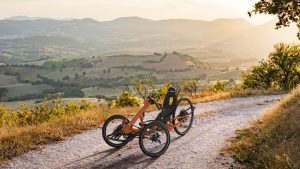
Frequently asked questions about recumbent bikes - Part 2
In today's post, I will answer two more, but somewhat more specific questions about recumbent bikes.
A few days ago, we answered four questions on our blog that are frequently asked before buying or using a recumbent bike. In today's post, I will answer two more, but somewhat more specific questions about recumbent bikes.
Don't you sit far too low on a recumbent bike?
On most recumbent bikes, the rider sits at about the same height as a car driver. On a conventional bike, on the other hand, the seat is usually set slightly higher. The recumbent rider is therefore at eye level with the cars and has a better view of the road. For this reason, they can react more quickly and also brake if an emergency situation arises. In addition, the recumbent cyclist sits firmly in the saddle even when braking hard and can generally brake more quickly due to the low centre of gravity. The risk of flying over the handlebars during hard braking is also eliminated. The fall height is therefore much higher on a normal bike. Legs and hands are much further away from the ground and can therefore only react more slowly in dangerous situations.
Can you ride a recumbent bike in the mountains?
You can definitely ride a recumbent bike in the mountains. The recumbent rider conquers the mountains by downshifting and maintaining a favourable pedalling frequency. The cyclist, on the other hand, pedals standing up when trying to climb the hills or inclines. For this feat of strength, the rider absolutely needs the support of the arms, as this is the only way to conquer steep inclines. A high level of training is absolutely essential for such a tour, as longer distances in particular are otherwise impossible to manage. In the Tour de France, for example, the participants ride in a seated position for as long as possible and only use the pedalling position in the sprint or at the end.
This means that the recumbent rider has a big advantage over the cyclist on longer distances. The seat of the recumbent supports the rider during the tour. They are therefore able to utilise their maximum leg power and cover long distances in the mountains. Unlike on a bicycle, the arms and upper body remain relaxed. Nevertheless, even a recumbent bike tour through the mountains requires some training and should only be attempted if you have already ridden many kilometres on your recumbent bike.
